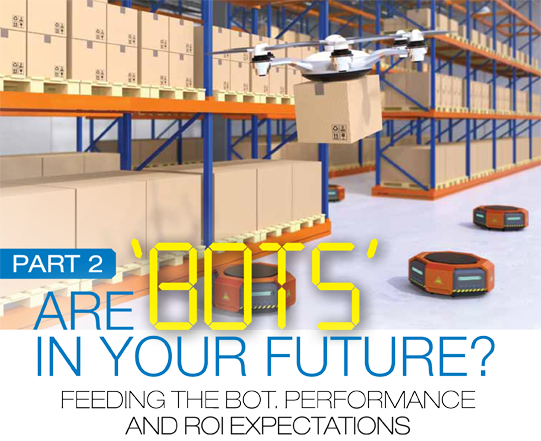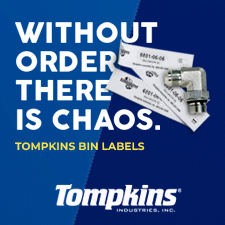Are Bots in Your Future? (Part 2)

By Howard Coleman
Imagine warehouse associates that work as long as you want them to – every day – for as many days as you need them. They never call in sick or show up late. They ask for no benefits, require no health insurance. They never complain. They spend every waking moment maximizing productivity, and their interactions with their co-workers are like a precise choreographed dance. Does this sound like a bunch of robots to you?
Our article, “Are Bots In Your Future?” (Jan./Feb. 2018) attempted to serve as a primer describing the rationale behind the growing forces becoming more evident: labor scarcity, prospects of higher labor rates, reduced reliance on temporary or unreliable labor pools and an aging workforce (since many millennials show little interest in warehouse work). These forces plus a robot’s extreme flexibility (they can move autonomously from one aisle to another), and the constant pressure to increase warehouse productivity are the driving forces that have already become a reality in many wholesale distribution environments.
The Key Success Criteria
In most warehouses, the most costly element in order picking and inventory put-away is the warehouse associates’ travel time. Often as much as 70 percent of their time is spent traveling (walking) to a specific warehouse destination. Travel time can therefore cap labor productivity. The bot reduces travel time. With bots, a warehouse associate can remain within a limited zone, handling the manual selection of items in the zones, while using the robot to move product between picking zones and the shipping or receiving area. So the key, the primary goal, is to control picking and put-away labor, and one way to do that is to cut the cost of travel time.
Periodically, the bots will autonomously retreat to a battery charging area; it’s like getting themselves a drink of water!
I suggest that most robot applications in the wholesale-distribution arena over the next few years will focus on collaborating with human warehouse associates, although some head count reduction should be expected as the bots contribute to higher warehouse through-put rates. So, for most wholesale distributors, the costs involved and the potential ROI will dictate their approach to this newer technology.
For some time into the near future, many bot applications will focus on the low-hanging fruit, fostering mobility (finding the stock locations for picking and inventory put-away placement), with much less walking around than now required by warehouse associates.
There is no doubt that robots can help (they can work multiple shifts without a coffee break) and have a place in a distribution center/warehouse to empower people for the simple reason that they lead warehouse associates through their work, collaborating and pushing those higher warehouse through-put rates.
The focus will be on looking for opportunities to dramatically increase warehouse associate productivity now and, ultimately, to avoid future costs down the road as a company continues to grow and its volumes increase. Depending on smart warehouse design and speed-of-flow initiatives, there will be a head count reduction impact, as fewer associates are required to feed the bot.
Cost Reduction
Can investing in robotics be truly worthwhile? It may still be questionable for smaller distributors based on our current research and internal cost-justification rationale, although some robotics vendors now offer attractive leasing alternatives as opposed to outright bot purchase. That being said, you won’t have to be an Amazon or Walmart to participate in this revolution.
The ROI
Most disciplined companies make capital expenditure decisions based on an expected ROI. For investments such as robotics, the ROI typically will be a function of increased efficiency gained through labor cost reduction and productivity/through-put increases, and other benefits such as increased order fulfillment accuracy, reduced cost of training, employee turnover reduction, inventory control improvements, reduced order cycle times and more.
I’ve found that the primary/critical success factors are really two-fold: 1) reduction of travel time (labor cost reduction/productivity improvement) and 2) the optimum ratio of warehouse-associates-to-bots.
- Consider a warehouse currently with 10 associates earning $19.50 an hour (fully burdened with benefits) and who spend up to 70 percent of their time travelling/walking even before they are in a position to complete the warehouse task transaction.
- Early research seems to indicate up to a 2X productivity increase (more lines picked with fewer people).
- That’s over $202,000 in labor savings per year
- The ratio of warehouse associates-to-bots is projected at three bots to each warehouse associate, and is the second factor I mentioned in the ROI equation. In our example, let’s say five warehouse associates would feed 15 bots at an estimated yearly lease cost of $171,000.
- Net savings = $31,000 per year; the larger the operation, the more savings.
- Smart design/speed-of-flow warehouse modifications, of course, will also influence the number of warehouse associates and positively impact productivity, providing increased through-put now, and future cost avoidance as your company continues to grow.
An operations assessment is a requirement, including customer and product profiles, activity metrics, business drivers, warehouse size and location(s) and number of warehouse employees, types of storage media employed, picking, receiving and put-away methods, outbound operations and the technology currently employed. This may initiate a need for warehouse process transformation or infrastructure changes before bot implementation.
My thanks to the folks at Locus Robotics for their assistance in providing background information.
Finally, to maintain a competitive advantage, progressive companies will now need to consider robotics to meet ongoing DC/warehouse and business improvement objectives. Who knows? Maybe warehouse associates may even be happy to let robots do the long-distance sprints! Will you be ready?
 Howard Coleman is principal of MCA Associates. Since 1986, the management consulting firm has worked with wholesale distribution and manufacturing companies that seek and are committed to operational excellence. Contact him at (203) 732-0603 or by email at hcoleman@mcaassociates.com.
Howard Coleman is principal of MCA Associates. Since 1986, the management consulting firm has worked with wholesale distribution and manufacturing companies that seek and are committed to operational excellence. Contact him at (203) 732-0603 or by email at hcoleman@mcaassociates.com.
This article originally appeared in the May/June 2018 issue of Industrial Supply magazine. Copyright 2018, Direct Business Media.













